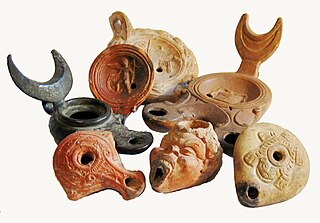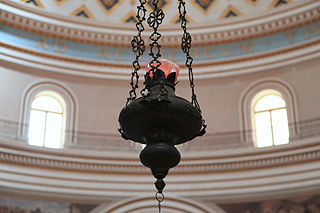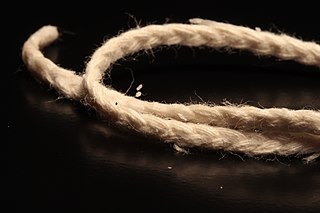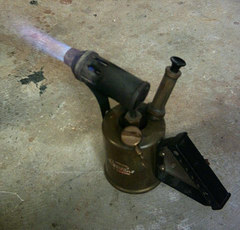Related Research Articles
Kerosene, paraffin, or lamp oil is a combustible hydrocarbon liquid which is derived from petroleum. It is widely used as a fuel in aviation as well as households. Its name derives from Greek: κηρός (keros) meaning "wax", and was registered as a trademark by Canadian geologist and inventor Abraham Gesner in 1854 before evolving into a generic trademark. It is sometimes spelled kerosine in scientific and industrial usage. The term kerosene is common in much of Argentina, Australia, Canada, India, New Zealand, Nigeria, and the United States, while the term paraffin is used in Chile, eastern Africa, South Africa, Norway, and in the United Kingdom. The term lamp oil, or the equivalent in the local languages, is common in the majority of Asia and the Southeastern United States. Liquid paraffin is a more viscous and highly refined product which is used as a laxative. Paraffin wax is a waxy solid extracted from petroleum.

A candle is an ignitable wick embedded in wax, or another flammable solid substance such as tallow, that provides light, and in some cases, a fragrance. A candle can also provide heat or a method of keeping time.

A kerosene lamp is a type of lighting device that uses kerosene as a fuel. Kerosene lamps have a wick or mantle as light source, protected by a glass chimney or globe; lamps may be used on a table, or hand-held lanterns may be used for portable lighting. Like oil lamps, they are useful for lighting without electricity, such as in regions without rural electrification, in electrified areas during power outages, at campsites, and on boats. There are three types of kerosene lamp: flat-wick, central-draught, and mantle lamp. Kerosene lanterns meant for portable use have a flat wick and are made in dead-flame, hot-blast, and cold-blast variants.

An oil lamp is a lamp used to produce light continuously for a period of time using an oil-based fuel source. The use of oil lamps began thousands of years ago and continues to this day, although their use is less common in modern times. They work in the same way as a candle but with fuel that is liquid at room temperature, so that a container for the oil is required. A textile wick drops down into the oil, and is lit at the end, burning the oil as it is drawn up the wick.

A sanctuary lamp, chancel lamp, altar lamp, everlasting light, or eternal flame is a light that shines before the altar of sanctuaries in many Jewish and Christian places of worship. Prescribed in Exodus 27:20-21 of the Torah, this icon has taken on different meanings in each of the religions that have adopted it. The passage, which refers to prescriptions for the tabernacle, states:
And thou shalt command the children of Israel, that they bring thee pure oil olive beaten for the light, to cause the lamp to burn always. In the tabernacle of the congregation without the veil, which is before the testimony, Aaron and his sons shall order it from evening to morning before the LORD: it shall be a statute for ever unto their generations on the behalf of the children of Israel. (KJV)

A lantern is an often portable source of lighting, typically featuring a protective enclosure for the light source – historically usually a candle or a wick in oil, and often a battery-powered light in modern times – to make it easier to carry and hang up, and make it more reliable outdoors or in drafty interiors. Lanterns may also be used for signaling, as torches, or as general light-sources outdoors.

A Bude-Light was a very bright oil lamp invented by Sir Goldsworthy Gurney, patented by him on 8 June 1839 and named after Bude, Cornwall, where he lived.

A candle wick is usually a braided cotton that holds the flame of an oil lamp or candle. A candle wick works by capillary action, conveying ("wicking") the fuel to the flame. When the liquid fuel, typically melted candle wax, reaches the flame it then vaporizes and combusts. The candle wick influences how the candle burns. Important characteristics of the wick include diameter, stiffness, fire-resistance, and tethering.

The New Presque Isle Light was built in 1870, at Presque Isle, Michigan, east of Grand Lake, and sits on the namesake peninsula. It is one of 149 lighthouses in Michigan, more than any other state. Because of changing shoreline particularly, or alternatively deterioration of the original building, it is not uncommon for a replacement lighthouse to be placed in the vicinity of an earlier light, in this case, the Old Presque Isle Light.

A kerosene heater, also known as a paraffin heater, is typically a portable, unvented, kerosene-fueled, space heating device. In Japan and other countries, they are a primary source of home heat. In the United States and Australia, they are a supplemental heat or a source of emergency heat during a power outage. Most kerosene heaters produce between 3.3 and 6.8 kilowatts.

The Argand lamp is a type of oil lamp invented in 1780 by Aimé Argand. Its output is 6 to 10 candelas, brighter than that of earlier lamps. Its more complete combustion of the candle wick and oil than in other lamps required much less frequent trimming of the wick.

A coal trimmer or trimmer is a position within the engineering department of a coal-fired ship which involves all coal handling duties. Their main task is to ensure that coal is evenly distributed within a vessel to ensure it remains trim in the water. Their efforts to control the fore-and-aft angle at which a ship floats is the reason they’re called “trimmers”. Without proper management of the coal bunkers, ships could easily list due to uneven distribution of the coal.

A candle snuffer, candle extinguisher, or douter is an instrument used to extinguish burning candles, consisting of a small cone at the end of a handle. The use of a snuffer helps to avoid problems associated with blowing hot wax and it avoids the smoke and odor of a smoldering wick which results from simply blowing a candle out. Extinguishers are still commonly used in homes and churches.
The J. Marhoffer was a steamboat that was wrecked on May 18, 1910, just south of Lincoln City, Oregon, United States. While underway to Portland under Captain Gustav Peterson, the vessel caught fire and ran aground at Boiler Bay, then known as Brigg's Landing. Her boiler still sits in the small inlet and can be viewed on calm days.

The Carcel lamp was an efficient lighting device used in the nineteenth century for domestic purposes and in France as the standard measure for illumination.
Esso Brussels was a commercial oil tanker built for the Esso Oil company in 1959. She was involved in a collision in 1973 in which thirteen of her crew perished. She was rebuilt and sailed under various other names until being scrapped in 1985.
Sea Witch was a MARAD Type C5-S-73b container ship built at the Bath Iron Works shipyard for American Export-Isbrandtsen Lines. She operated in the Atlantic trades for five years. So engaged on the evening of June 1, 1973, the vessel was involved in a disastrous collision with the oil tanker Esso Brussels in lower New York Harbor and was damaged so badly that she was removed from active service.
The Petroleum Warfare Department (PWD) was a government department established in Britain in 1940 in response to the invasion crisis during World War II, when Germany apparently would invade the country. The department was initially tasked with developing the uses of petroleum as a weapon of war, and it oversaw the introduction of a wide range of flame warfare weapons. Later in the war, the department was instrumental in the creation of the Fog Investigation and Dispersal Operation that cleared runways of fog allowing the landing of aircraft returning from bombing raids over Germany in poor visibility, and Operation Pluto, which installed prefabricated fuel pipelines between England and France soon after the Allied invasion of Normandy in June 1944.

A blowtorch is a fuel-burning tool used for applying flame and heat to various applications, usually metalworking.
A Wells light was a large paraffin-fuelled (kerosene) blowlamp used for engineering work, particularly for illumination, in Victorian times. At a time before widespread electrical lighting, they were the most common form of high-powered portable illumination used for construction work, particularly railways, civil engineering, shipyards and ironworks.
References
- ↑ Personnel, United States Bureau of Naval (1869). The Rule of the Road at Sea and in Inland Waters: Or, Steering and Sailing Rules. Collisions and Law of the Port Helm. U.S. Government Printing Office. p. 116.
... there is what is called a lamp-trimmer in Her Majesty's ships.
- ↑ The practical mechanic's journal. Longman. 1867. p. 61.